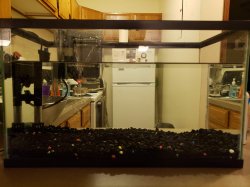I assume the tank has been filled up a bit more since the picture was taken?
HOB (hang on back) style filters like the Aquaclear 30 need the water level in the aquarium to be higher than the motor on the filter. If the tank water level is too low and there is a power failure, the filter will drain completely and won't restart when the power comes back on.
re: the Aquaclear, they usually come with a sponge, bag of carbon (black granules in a mesh bag) and some ceramic beads. I normally leave the beads and carbon in the box and just add 3 sponges. You buy the sponges separately. You can use the ceramic beads if you like but the carbon is not necessary unless you have chemicals or heavy metals in the water supply.
After the tank has cycled, add some fish and wait a couple more weeks before cleaning the filter. When it come to cleaning the filter, turn the filter off at the power point and unplug it. Get a bucket of water from the tank and rinse the ceramic beads in the bucket of tank water. When it is clean put the beads in the aquarium. Then squeeze the sponge out in the bucket of tank water. When it is clean, get a second bucket of tank water and squeeze it out in that. Then put the sponge in the tank. The carbon normally gets thrown away each month and is not necessary so get another sponge and swap it over.
After you have cleaned the sponge/s and ceramic beads, remove the filter from the tank and tip the water out onto the garden. Take the intake tubes off and wash them under tap water and rinse the filter case under tap water. Turn the motor and gently pull it down away from the filter case. Take the impellor out of the motor and wash it and the motor under tap water. The Aquaclear motors are sealed in a plastic resin and covered in a plastic case so it is safe to rinse them under tap water.
After you have cleaned the motor, put the impellor back in the motor and smear a thin layer of Vaseline on the O-ring on the top of the motor. Reassemble the motor and case and put the filter back on the tank. Put the intake tubes back on. Put the filter media in the filter and fill the filter case with tank water. Make sure the plug is dry and plug the filter in and turn it on. The filter will suck the tank water in and blow a few bubbles through the filter media before it gets going properly but it should be running normally within about 20 seconds.
Power Filters like the Aquaclear 30 should be cleaned at least once a month and every 2 weeks is better. If well maintained these filters can last for 20 years or more.
The other thing you can do with this filter is put a cylindrical sponge on the intake strainer. You get these sponges from pet shops and they are normally used in internal power filters. They add extra filtration to the tank and stop fish getting drawn onto the intake strainer, which can happen if the fish is unwell.
----------------------------
Is there any chance you can return the tank and get one that is slightly bigger?
The tank doesn't have fish in yet and if you get a longer tank it would give you more options for the fish.
If you drain the tank and keep the water in a bucket, and put the filter materials in the bucket of water, carefully remove the gravel, rinse and dry the tank, you might be able to swap it for a bigger tank (and pay the difference in price). But a longer tank would give you much more choice in what you can keep. Don't tell the pet shop it was set up.





